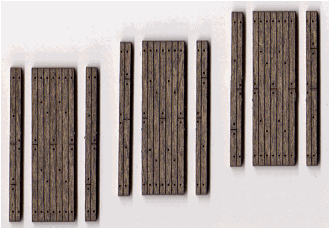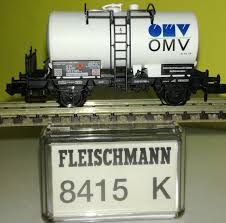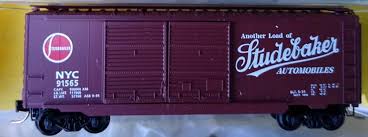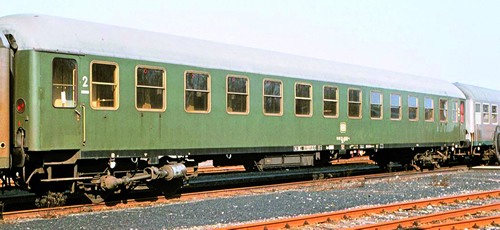Specific Item Information: Reporting number not readable.
Model Information: This generic body style comprises 1st class (A), 2nd class (B), mixed 1st/2nd class (AB) or restaurant (WR) cars of type UIC-X (formerly Deutsche Bundesbahn type m or type üm), used by several continental European railroads. Covers Epoch III to V.
Can be equipped with internal lighting ref. 9447 or 944701
Can be equipped with internal lighting ref. 9447 or 944701
Prototype History: The UIC (Union International des Chemins de fer) type X is a type of passenger car defined in 1961 by UIC bulletin 567, together with UIC type Y. They have been standardized based on the design introduced after WWII by the Deutsche Bundesbahn (DB) for its express cars, that was known as üm-Wagen or m-Wagen. The length of the UIC-X cars was the longest of all passenger cars built until then; this length has been kept identical for the UIC-Z type introduced in the 1970's.
Several thousands of these cars have been built for the major western European railways: Germany (DB), Italy (FS), Spain (RENFE), Switzerland (SBB-CFF-FFS), Austria (ÖBB)
From Wikipedia (in French)
See also these detailed articles (in Italian) for more information about both the prototypes and the N scale models: UIC-X.
Several thousands of these cars have been built for the major western European railways: Germany (DB), Italy (FS), Spain (RENFE), Switzerland (SBB-CFF-FFS), Austria (ÖBB)
- Deutsche Bundesbahn (DB) : a total of 6,145 UIC-X cars in 3 series (53, 61, 63) of various types - Am (1st class), ABm (1st/2nd class), Bm (2nd class), Bcm (sleeper), BDms (Baggage), ARm (1st class diner) et BRbumh (2nd class diner/bar)
- Ferrovie dello Stato (FS): a total of 4,746 UIC-X cars in 7 series (64, 66-68, 68, 70, 75, 79-82) of various types - A (1st class), AB (1st/2nd class), B (2nd class), Bc (sleeper), AcBc (sleeper). And also ...
- 163 Railway Post office cars: UIz Type 1964 (20), UIz Type 1968 (30), UMIz Type 1970 (33), UMIz Type 1976 (80)
- 317 Baggage cars: Dz UIC-X 1968 (60), Dz UIC-X 1970 (77), Dz–D UIC-X 1975 & 1982 (93), nD UIC-X 1987 (80), D UIC-X 1982 GC (7)
- Spanish Railways (RENFE) - Serie 8000: a total of 883 UIC-X cars built between 1961 and 1973, of various types: 121 AA or A10r-8000 (1st class), 6 AAB or A5B5-8000 (1st/2nd class), 15 BB or B10r-8000 (2nd class), 445 BB or B12r-8500 (2nd class), 117 BBL or Bc10r-8100 (sleeper), 8 RRR or R8-8000 (diner), 90 DD or D8-8000 (Baggage), 62 DDT (Baggage), 25 DDET (Baggage/RPO)
- Federal Swiss Railways (SBB-CFF-FFS) : 40 Am (1st class), 20 ABm (1st/2nd class), 320 Bm (2nd class), 50 Bcm (sleeper), 10 WRm (diner), 20 Dms (Baggage)
- Austrian Railways (ÖBB): 90 Bcmz (sleeper, derived from the Swiss type)
From Wikipedia (in French)
See also these detailed articles (in Italian) for more information about both the prototypes and the N scale models: UIC-X.
Road Name History: 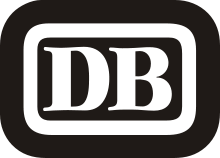 Deutsche Bundesbahn was the Western Germany DB before reunification. After World War II, Germany (and the DRG) was divided into 4 zones: US, British, French and Soviet. The first three eventually combined to form the Federal Republic of Germany (the West) and the Russian zone became the German Democratic Republic (the East). German territories beyond the Oder were ceded to Poland except for the northern part of East Prussia, which was ceded to the Soviet Union in 1945.
Deutsche Bundesbahn was the Western Germany DB before reunification. After World War II, Germany (and the DRG) was divided into 4 zones: US, British, French and Soviet. The first three eventually combined to form the Federal Republic of Germany (the West) and the Russian zone became the German Democratic Republic (the East). German territories beyond the Oder were ceded to Poland except for the northern part of East Prussia, which was ceded to the Soviet Union in 1945.
From 1949, the new governments assumed authority for railway operations. The DRG's (or DR's) successors were named Deutsche Bundesbahn (DB, German Federal Railways) in West Germany, and Deutsche Reichsbahn (DR, German State Railways) in East Germany kept the old name to hold tracking rights in western Berlin.
Unlike the DRG, which was a corporation, both the DB and the DR were federal state institutions, directly controlled by their respective transportation ministries. Railway service between East and West was restricted; there were around five well-controlled and secure checkpoints between West and East Germany, and about the same number between East Germany and West Berlin. Four transit routes existed between West Germany and West Berlin; citizens of West Berlin and West Germany were able to use these without too much harassment by the East German authorities.
The DB started in 1968 with changing the locomotive and passenger car serial numbers to the UIC norm. In 1970 the DR followed. The DB started experimenting with the Intercity trains in a new livery (bright orange).
In 1989, the Wall fell. Train frequency rapidly increased on the existing East/West corridors; closed links which had formerly crossed the border were re-opened. On 3 October 1990, Germany was reunified; however, this was not immediately the case with the railways. Administrative and organisational problems led to the decision to completely re-organize and reconnect Germany's railways. The so-called Bahnreform (Railway Reform) came into effect on 1 January 1994, when the State railways Deutsche Bundesbahn and Deutsche Reichsbahn were formally reunited to form the current German Railway Corporation (Deutsche Bahn).
From Wikipedia

From 1949, the new governments assumed authority for railway operations. The DRG's (or DR's) successors were named Deutsche Bundesbahn (DB, German Federal Railways) in West Germany, and Deutsche Reichsbahn (DR, German State Railways) in East Germany kept the old name to hold tracking rights in western Berlin.
Unlike the DRG, which was a corporation, both the DB and the DR were federal state institutions, directly controlled by their respective transportation ministries. Railway service between East and West was restricted; there were around five well-controlled and secure checkpoints between West and East Germany, and about the same number between East Germany and West Berlin. Four transit routes existed between West Germany and West Berlin; citizens of West Berlin and West Germany were able to use these without too much harassment by the East German authorities.
The DB started in 1968 with changing the locomotive and passenger car serial numbers to the UIC norm. In 1970 the DR followed. The DB started experimenting with the Intercity trains in a new livery (bright orange).
In 1989, the Wall fell. Train frequency rapidly increased on the existing East/West corridors; closed links which had formerly crossed the border were re-opened. On 3 October 1990, Germany was reunified; however, this was not immediately the case with the railways. Administrative and organisational problems led to the decision to completely re-organize and reconnect Germany's railways. The so-called Bahnreform (Railway Reform) came into effect on 1 January 1994, when the State railways Deutsche Bundesbahn and Deutsche Reichsbahn were formally reunited to form the current German Railway Corporation (Deutsche Bahn).
From Wikipedia
Brand/Importer Information: As a high-quality company we set the standard when it comes to prototype fidelity and functionality. Our aim is to enthrall novices and experts alike and to be the enduring long-term partner for a fascinating hobby that spans all generations. We achieve this with the true-to-detail design and the reliability of our models and with innovations that offer a new dimension in the play value and fun factor. The high commitment to quality that has characterised Fleischmann for more than 125 years has ensured our company?s position as an internationally leading brand for model railways.
Small-scale greatness. Its comprehensive range in the N scale makes Fleischmann the international market leader in this sector. There are over 350 highly detailed models to choose from in the space-saving 9-mm gauge. Continuous and targeted extension of the range will allow Fleischmann to expand its competitive edge in the future.
Small-scale greatness. Its comprehensive range in the N scale makes Fleischmann the international market leader in this sector. There are over 350 highly detailed models to choose from in the space-saving 9-mm gauge. Continuous and targeted extension of the range will allow Fleischmann to expand its competitive edge in the future.
Item created by: mbierbauer on 2019-04-20 00:54:26. Last edited by CNW400 on 2020-07-13 10:06:39
If you see errors or missing data in this entry, please feel free to log in and edit it. Anyone with a Gmail account can log in instantly.
If you see errors or missing data in this entry, please feel free to log in and edit it. Anyone with a Gmail account can log in instantly.





